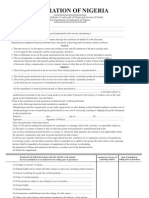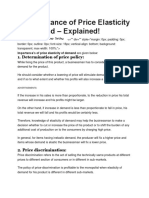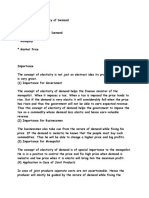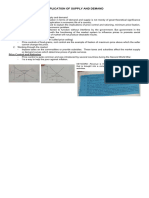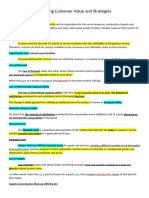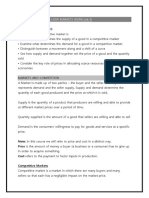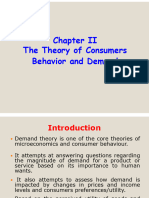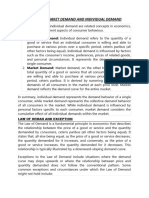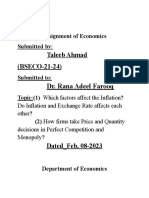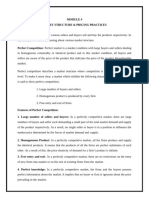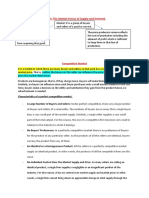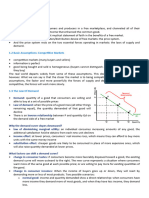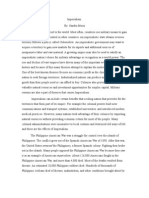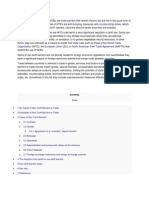Price and Income
Price and Income
Uploaded by
Nishant JainCopyright:
Available Formats
Price and Income
Price and Income
Uploaded by
Nishant JainCopyright
Available Formats
Share this document
Did you find this document useful?
Is this content inappropriate?
Copyright:
Available Formats
Price and Income
Price and Income
Uploaded by
Nishant JainCopyright:
Available Formats
The concept of elasticity is not just an abstract idea its practical importance is very great.
(1) Importance For Government The concept of elasticity of demand helps the finance minister of the monopolist. When it imposes a tax. When a tax is imposed the price tends to rise. But if the demand is very elastic it will considerably fall when the price has risen and thus the government will not be able to earn expected revenue. Thus this concept of elasticity of demand helps the government to impose the tax on a commodity whose demand lass elastic and hence earn valuable revenue. (2) Importance for Businessmen The businessmen also take cue from the nature of demand while fixing his price. IF the demand is inelastic he knows that the people must buy such commodities. Thus he will be able to change a higher price and big profits. (3) Importance for Monopolist The concept of elasticity of demand is of special importance to the monopolist. He is in a position to control the price and fix high price when demand is inelastic and low price when it is elastic will bring him the maximum profit. (4) Application in Case of Joint Products In case of joint products seperate costs are not ascertainable. Hence the producer will mostly be guided by the nature of demand while fixing the price. (5) Determinitation of Wages The concept of elasticity of demand influences the determination of wages of a particular type of labour. If the demand of particular type of labour is inelastic trade union can easily get their wages raised. On the other hand of the demand for labour is relatively elastic trade union trade unions may not be successful in raising wages. (6) Importance for International Trade The concept of elasticity of demand is used in calculating the terms of trade. Whenever a country fees an adverse balance of payment the government considers the elasticity of demand for the countries export and imports before devaluing its currency. Price Determines the Demand The demand for the commodity is related to price. IT is always at a price. Prof. Beaham defines as under:
The demand for anything at a given price is the amount of it which will be brought per unit of time at that price. Demand varies with price. It varies inversely with price. If the price rises the demand contracts and if the price falls the demand extends. This responsiveness depends on many factors the effective demand for necessaries generally do not change with price. In other words the effective demand for necessaries is inelastic. The may rise or fall but the effective demand for necessaries remain practically the same. The effective demand for comforts is elastic. In other words variation in for comforts is in perpotion to a change in price. Monopoly Monopoly is that market from in which the single producer controls the whole supply of a single commodity that has no close substitutes. Two points must be noted in regard to the definition. First there must be an individual owner it seller if. There will be monopoly. That single producer may be individual owner or group of partners or a joint stock company or any other combination of producers of the state. Hence there must be a sole producer or seller in the market if it is to be called monopoly. Secondly, the commodity produced by the producer must have no close substitutes. Competing if he is to be called a monopolist this ensures that there must no rival of the monopolist. By the absence of closer substitutes we mean that there are no other firms producing similar products or product varying only slightly from that of the monopolist. The above two conditions ensure that the monopolist can set the price of his product and can pursue an independent price policy. POWER TO INFLUENCE PRICE IS THE VERY ESSENCE OF MONOPOLY. Market Price Market price is the actual price that prevails in the market at any particular time. It never remains constant. It changes from day to day and even from moment to moment. It can change at any time at any moment. Determination of Market Price Market price is determined by the relative forces of demand and supply. The demand depends upon the satisfaction, which a consumer drives from the consumption of the commodity. Supply on the other hand depends upon the cost of production of the commodity. The consumer tries to achieve more and more satisfaction least possible expenditure. He does not pay more than the marginal utility of the commodity to him the seller on the other hand tries to maximize his profit by changing as much as he can. He will never accept the price which is less
than the marginal cost of production of the commodity and thus marginal utility and marginal cost pf production are the two limits the maximum and the minimum and price is determined between these two limits, so we can say that, The price is determined at point where the amounts demanded and offered for sale are equal. ****
1. Determination of price policy:
While fixing the price of this product, a businessman has to consider the elasticity of demand for the product. He should consider whether a lowering of price will stimulate demand for his product, and if so to what extent and whether his profits will also increase a result thereof. If the increase in his sales is more than proportionate, to the reduction in price his total revenue will increase and his profits might be larger. On the other hand, if increase in demand is less than proportionate to fall in price, his total revenue we will fall and his profits would be certainly less. Therefore, knowledge of elasticity of demand may help the businessman to make a decision whether to cut or increase the price of his product or to shift the burden of any additional cost of production on to the consumers by charging high price. In general, for items having inelastic demand, the producer will fix a higher price and items whose demand is elastic the businessman will fix a lower price.
2. Price discrimination:
Price discrimination refers to the act of selling the technically same products at different prices to different section of consumers or in different in sub-markets. The policy of price-discrimination is profitable to the monopolist when elasticity of demand for his product is different in different sub-markets. Those consumers whose demand is inelastic can be charged a higher price than those with more elastic demand.
3. Shifting of tax burden:
To what extent a producer can shift the burden of indirect tax to the buyers by increasing price of his product depends upon the degree of elasticity of demand. If the demand is inelastic the larger part of the indirect tax can be shifted upon buyers by increasing price. On the other hand if the demand is elastic than the burden of tax will be more on the producer.
4. Taxation and subsidy policy:
The government can impose higher taxes and collect more revenue if the demand for the commodity on which a tax is to be levied is inelastic. On the other hand, in ease of a commodity with elastic demand high tax rates may fail to bring in the required revenue for the government. Govt., should provide subsidy on those goods whose demand is elastic and in the production of the commodity the law of increasing returns operates.
5. Importance in international trade:
The concept of elasticity of demand is of crucial importance in many aspects of international trade. The success of the policy of devaluation to correct the adverse balance of payment depends upon the elasticity of demand for exports and imports of the country. The policy of devaluation would be benificial when demand for exports and imports is priceelastic. A country will benefit from international trade when: (i) it fixes lower price for exports items whose demand is price elastic and high price for those exports whose demand is inelastic (ii) the demand for imports should be inelastic for a fall in price and inelastic for arise in price. The terms of trade between the two countries also depends upon the elasticity of demand of exports and imports of two countries. If the demand is inelastic, the terms of trade will be in favour of the seller country.
6. Importance in the determination of factors prices:
Factor with an inelastic demand can always command a higher price as compared to a factor with relatively elastic demand. This helps the trade unions in knowing that where they can easily get the wage rate increased. Bargaining capacity of trade unions depend upon elasticity of demand for workers services.
7. Determination of sale policy for supper markets:
Super Markets is a market where in a variety of goods are sold by a single organization. These items are generally of mass consumption. Therefore, the organization is supposed to sell commodities at lower prices than charged by shopkeepers in the other bazars. Thus, the policy adopted is to charge a slightly lower price for items whose demand is relatively elastic and the costs are covered by increased sales.
8. Pricing of joint supply products:
The goods that are produced by a single production process are joint supply products. The cost of production of these goods is also joint. Therefore, while determining the prices of these products their elasticity of demand is considered. The price of a joint supply product is fixed high if its demand is inelastic and low price is fixed for that joint supply product whose demand is elastic.
9. Effect of use of machines on employment:
Ordinarily it is thought that use of machines reduced the demand for labour. Therefore, trade unions often oppose the use of machines fearing unemployment. But this fear is not always true because use of machines may not reduce demand for labour. It depends on the price elasticity of demand for the products. The use of machines may reduce the cost of production and price. If the demand of the product is elastic then the fall in price will increase demand significantly.
As a result of increased demand the production will also increase and more workers will be employed. In such cases concept of elasticity of demand help the management to pacify the trade unions. But if the demand of the product is inelastic than use of more machines will cause unemployment.
10. Public utilities:
The nationalization of public utility services can also be justified with the help of elasticity of demand. Demand for public utilities such as electricity, water supply, post and telegraph, public transportation etc. is generally inelastic in nature. If the operation of such utilities is left in the hand of private individuals, they may exploit the consumers by charging high prices. Therefore, in the interest of general public, the government owns and runs such services. The public utility enterprises decide their price policy on the basis of elasticity of demand. A suitable price policy for public utility enterprises is to charge from consumers according to their elasticity of demand for public utility.
11. Explanation of paradox of poverty:
Exceptionally good harvest brings poverty to the farmers and this situation is called Paradox of Poverty. This paradox is easily explained by the inelastic nature of demand for most farm products. Since the demand is inelastic, prices of farm products fall sharply as a result of large increase in their supply in the year of bumper crops. Due to sharp fall in prices, the farmers get less income even by selling larger quantity. This paradox of poverty is the basis of regulation and control of farm products prices. Government fixes the minimum prices of farm products because the demand for farm products is inelastic. Thus, the concept of elasticity of demand helps the government in determining its agricultural policies.
12. Output decisions:
The elasticity of demand helps the businessman to decide about production. A businessman chooses the optimum product- mix on the basis of elasticity of demand for various products. The products having more elastic demand are preferred by the businessmen. The sale of such products can be increased with a little reduction in their prices. From the above discussion it is amply clear that price elasticity of demand is of great significance in making business decisions.
You might also like
- CCVODocument2 pagesCCVOJason Chau71% (7)
- (REV) Partial Scope Agreement Brazil-Guyana (English)Document14 pages(REV) Partial Scope Agreement Brazil-Guyana (English)candykisses100% (1)
- A level Economics Revision: Cheeky Revision ShortcutsFrom EverandA level Economics Revision: Cheeky Revision ShortcutsRating: 3 out of 5 stars3/5 (1)
- Multinational CompaniesDocument19 pagesMultinational CompaniesAmishi Trivedi100% (1)
- Cusdec Final SADDocument5 pagesCusdec Final SADSamantha Swift0% (1)
- Cost and Account Management: Leather Industry in IndiaDocument9 pagesCost and Account Management: Leather Industry in IndiaSourabhNo ratings yet
- Importance of PEDDocument6 pagesImportance of PEDDylan ChiparaNo ratings yet
- 12 Importance of Price Elasticity of DemandDocument5 pages12 Importance of Price Elasticity of DemandVom Samourais50% (2)
- Importance of Elasticity of DemandDocument3 pagesImportance of Elasticity of DemandNighat SaeedNo ratings yet
- Importance of Ed in Managerial Decision MakingDocument10 pagesImportance of Ed in Managerial Decision MakingVijay Singh Kumar Vijay100% (1)
- Application of Supply and DemandDocument3 pagesApplication of Supply and DemandJoan DardoNo ratings yet
- Price Elasticity of Demand ApplicationsDocument5 pagesPrice Elasticity of Demand ApplicationsramkrishnagnNo ratings yet
- Model Answers For EABDDocument21 pagesModel Answers For EABDrokadegauravshreeNo ratings yet
- Mefa Unit-3Document20 pagesMefa Unit-3rosieNo ratings yet
- BEFA Unit 2 BSBDocument7 pagesBEFA Unit 2 BSBBodapati Sai bhargav2002No ratings yet
- ECONOMICSDocument3 pagesECONOMICSMoeeg MoeegNo ratings yet
- Pricing Strategy ReviewerDocument11 pagesPricing Strategy ReviewerGerazo, Kaye Jeacinne V.No ratings yet
- SHORT ANSWERS (8 Marks) What Is Price Discrimination? Explain The Basis of Price DiscriminationDocument36 pagesSHORT ANSWERS (8 Marks) What Is Price Discrimination? Explain The Basis of Price DiscriminationSathish KrishnaNo ratings yet
- ACC08/FMS01 Lectures: Economic Foundation of Financial ManagementDocument15 pagesACC08/FMS01 Lectures: Economic Foundation of Financial ManagementmiolataNo ratings yet
- Long Questions 1. Difference Between Micro and Macro EconomicsDocument24 pagesLong Questions 1. Difference Between Micro and Macro EconomicsMac 02novNo ratings yet
- Economics Chapter 2 Market AnalysisDocument46 pagesEconomics Chapter 2 Market Analysisddbhanderi6002No ratings yet
- Supply and DemandDocument19 pagesSupply and DemandUnicorn ProjectNo ratings yet
- Managerial EconomicsDocument10 pagesManagerial EconomicsNaveenmanuelcabralNo ratings yet
- Mba 0042Document4 pagesMba 0042Ashish YadavNo ratings yet
- Wk10 11 - Basic MicroeconomicsDocument10 pagesWk10 11 - Basic MicroeconomicsWhats PoppinNo ratings yet
- Lesson 13 - Econ 2 (Abegail Blanco Mm2-I)Document14 pagesLesson 13 - Econ 2 (Abegail Blanco Mm2-I)Abegail BlancoNo ratings yet
- MB0042 Managerial Economics Assig Set-1Document8 pagesMB0042 Managerial Economics Assig Set-1Sushanth PerambraNo ratings yet
- 5.2 What Determines Price Elasticity of Demand?Document8 pages5.2 What Determines Price Elasticity of Demand?serrajNo ratings yet
- Applied Economics Week 5Document8 pagesApplied Economics Week 5SETH JOHN AGRUDANo ratings yet
- MG 2452 Engineering Economics and Financial AccountingDocument16 pagesMG 2452 Engineering Economics and Financial AccountingSanthosh Raja ANo ratings yet
- Me 2Document79 pagesMe 2animut silesheNo ratings yet
- Meaning of DemandDocument12 pagesMeaning of DemandAnonymous NSNpGa3T93No ratings yet
- International School of Business and Technology: Course WorkDocument20 pagesInternational School of Business and Technology: Course WorkttwahirwaNo ratings yet
- Managerial Economics: Ii: Demand and SupplyDocument74 pagesManagerial Economics: Ii: Demand and Supplykewani negashNo ratings yet
- Ques1. What Is Price Discrimination? Explain The Basis of Price Iscrimination. (5+5)Document10 pagesQues1. What Is Price Discrimination? Explain The Basis of Price Iscrimination. (5+5)Sushanth PerambraNo ratings yet
- ECONOMICs PERFECT COMPETITIONDocument10 pagesECONOMICs PERFECT COMPETITIONvjeevasanjay52No ratings yet
- Chapter 1Document15 pagesChapter 1James SitohangNo ratings yet
- Year 12 Presentation - Unit 2 - MicroeconomicsDocument279 pagesYear 12 Presentation - Unit 2 - Microeconomicsakash4690No ratings yet
- Monopolistic-WPS OfficeDocument4 pagesMonopolistic-WPS OfficeJoko PrihantoNo ratings yet
- Dmba105 - Managerial EconomicsDocument12 pagesDmba105 - Managerial EconomicsMuhammed AdnanNo ratings yet
- EconomicsDocument19 pagesEconomicssaikat.pal23-25No ratings yet
- Module 4 (Elasticity of Demand and Supply)Document21 pagesModule 4 (Elasticity of Demand and Supply)Sagar GuptaNo ratings yet
- Summary of Demand, Supply, and Market EquilibriumDocument3 pagesSummary of Demand, Supply, and Market EquilibriumAndreas Audi KemalNo ratings yet
- IB Economics - Microeconomics NotesDocument15 pagesIB Economics - Microeconomics NotesMICHELLE KARTIKA HS STUDENT100% (1)
- Princilpls of EconomicsDocument31 pagesPrincilpls of EconomicsRubina HannureNo ratings yet
- Assignment EconomicsDocument7 pagesAssignment EconomicsMuhammad Zeshan AliNo ratings yet
- Elasticity of DemandDocument9 pagesElasticity of DemandHimanshu RajpootNo ratings yet
- 1) Equilibrium Price in The Short RunDocument12 pages1) Equilibrium Price in The Short RunAathi VishNo ratings yet
- Unit:-2 By:-Manoj Kumar GautamDocument78 pagesUnit:-2 By:-Manoj Kumar GautamPiyush ChaturvediNo ratings yet
- SwebeDocument3 pagesSwebeJuma SimbanoNo ratings yet
- Main Features of Perfect CompetitionDocument6 pagesMain Features of Perfect CompetitionStorm BreakerNo ratings yet
- MARKET STRUCTURE - 4th UnitDocument22 pagesMARKET STRUCTURE - 4th UnitDr VIRUPAKSHA GOUD GNo ratings yet
- Module 4Document25 pagesModule 4jahnaviramesh1995No ratings yet
- Chap 3: The Market Forces of Supply and DemandDocument5 pagesChap 3: The Market Forces of Supply and DemandKendraNo ratings yet
- Mefa 3 4 5Document72 pagesMefa 3 4 5Sumit RoyNo ratings yet
- Homework 4-6Document4 pagesHomework 4-6iamnadim23No ratings yet
- Unit IV Answers OriginalDocument11 pagesUnit IV Answers OriginalRutvij GiteNo ratings yet
- Types of Economic MarketDocument3 pagesTypes of Economic MarketMeghan Kaye LiwenNo ratings yet
- Summary MacroDocument64 pagesSummary Macrojayesh.guptaNo ratings yet
- BA 210 MANAGERIAL ECONOMICS - Module 5 - Balin, LDocument26 pagesBA 210 MANAGERIAL ECONOMICS - Module 5 - Balin, LMarianne PeritNo ratings yet
- Micro g8Document25 pagesMicro g8Mary HealyNo ratings yet
- UntitledDocument10 pagesUntitledCKEC-CSE IVNo ratings yet
- Pricing TheoryDocument12 pagesPricing TheoryZubair Hussain AdeshinaNo ratings yet
- 1629204622-1. Basic of MicroeconomicDocument5 pages1629204622-1. Basic of MicroeconomicTigerNo ratings yet
- Summary of Austin Frakt & Mike Piper's Microeconomics Made SimpleFrom EverandSummary of Austin Frakt & Mike Piper's Microeconomics Made SimpleNo ratings yet
- Performance Task ImperialismDocument2 pagesPerformance Task ImperialismSandra MouaNo ratings yet
- PESTLE AnalysisDocument3 pagesPESTLE AnalysisGladys CanterosNo ratings yet
- Application Form For The Registration of Importers & ExportersDocument4 pagesApplication Form For The Registration of Importers & ExportersNilamdeen Mohamed ZamilNo ratings yet
- All Five-Year Plans of Pakistan Were Failures PDFDocument3 pagesAll Five-Year Plans of Pakistan Were Failures PDFRahmatullah MardanviNo ratings yet
- The Impact of Energy Crisis On Textile SectorDocument4 pagesThe Impact of Energy Crisis On Textile SectorAymen SaeedNo ratings yet
- Export Business Plan For SLESDocument9 pagesExport Business Plan For SLESDivakar BindNo ratings yet
- Cdocumentary Letter of Credit in Apparel IndustryDocument3 pagesCdocumentary Letter of Credit in Apparel Industrysuman_ishaNo ratings yet
- ACFTADocument24 pagesACFTADhany Laoh DamopoliiNo ratings yet
- Port of Auckland Technical DocumentDocument35 pagesPort of Auckland Technical DocumentBen RossNo ratings yet
- Gulahmed 130119002421 Phpapp01Document28 pagesGulahmed 130119002421 Phpapp01Ahmed BelalNo ratings yet
- Taiwan: and Its Economic DevelopmentDocument30 pagesTaiwan: and Its Economic DevelopmentBimsara WijayarathneNo ratings yet
- Ch01 VersCDocument47 pagesCh01 VersCBren FlakesNo ratings yet
- Strategic Marketing Ranjan Challa ShridharaDocument18 pagesStrategic Marketing Ranjan Challa ShridharaAnonymous mVQ1dRqu9YNo ratings yet
- Gunnar Myrdal Paths of DevelopmentDocument10 pagesGunnar Myrdal Paths of DevelopmentaalgazeNo ratings yet
- World: Footwear - Market Report. Analysis and Forecast To 2020Document8 pagesWorld: Footwear - Market Report. Analysis and Forecast To 2020IndexBox MarketingNo ratings yet
- Assignment 2Document6 pagesAssignment 2ShubhamJainNo ratings yet
- Non Tariff BarriersDocument12 pagesNon Tariff BarriersPrathamesh GhorpadeNo ratings yet
- Summarized Report of Group 1Document5 pagesSummarized Report of Group 1Caryl Relos BasterechiaNo ratings yet
- Nigeria Rice-Industry-ReviewDocument37 pagesNigeria Rice-Industry-Reviewladiasuni100% (3)
- CoCom Lists Supplement - 1993Document64 pagesCoCom Lists Supplement - 1993Samuel EvansNo ratings yet
- Lecture 35Document21 pagesLecture 35praneix100% (1)
- Lesson Plan GNPDocument2 pagesLesson Plan GNPmanilyn100% (1)
- Suchendra Prasad Sangam Road Narere: P.O. BOX 48, SUVA, FIJI. PH: (679) 331 3155Document4 pagesSuchendra Prasad Sangam Road Narere: P.O. BOX 48, SUVA, FIJI. PH: (679) 331 3155Anonymous taLJmiDF3No ratings yet
- PomegranateDocument13 pagesPomegranatevaalfNo ratings yet
- GST Presentation - Place of Supply of GoodsDocument15 pagesGST Presentation - Place of Supply of GoodsAditi AgarwalNo ratings yet
